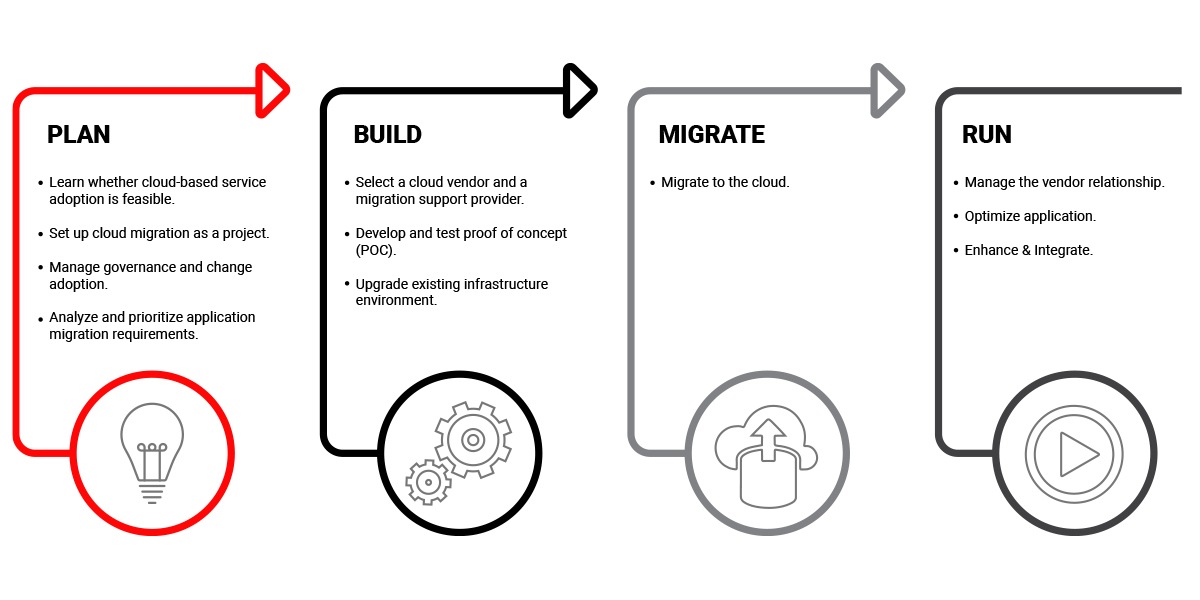Many organizations now want to take advantage of cost efficiency, scalability, security, and other benefits the cloud offers. For Oracle customers migration to Public cloud for their mission critical application, OCI automatically comes to the top of their assessment list. However this blog is relevant even if you are exploring AWS or GCP or any other public cloud provider for your Oracle application.
EBS migration to Oracle public cloud infrastructure has to be planned and relevant questions needs to be answered, and you should also be aware of potential challenges to avoid at each stage of your EBS migration journey. You will have to identify and engage with relevant stakeholders and internal team members to make timely decisions and ensure the project is executed with a tentative timeline for each and every phase.
This blog will help you guide with the key considerations for each of the phases of the Public cloud migration journey.
4 Phases of Cloud Migration

Considerations for Each Phase of Cloud Migration
A. Planning Phase
1. Learn Whether Cloud-Based Service Adoption is Practical & Feasible
Beyond the agility, flexibility and cost savings the cloud brings to the table, trends and technologies driving digital transformation today are also behind the mass migration to cloud computing. Cost vs benefits to be incurred for migration EBS to Cloud have to be assessed at this planning stage. Oracle has made this decision easy by simplifying the process by which EBS can be easily migrated to OCI, which might not be the case while migrating to AWS or GCP.
Trying to keep up with this growing demand for capacity is a difficult and costly onprem. A decision during a technology refresh cycle to move to cloud will be easy by justifying cost vs benefits.
2. Set up Cloud Migration as a Project
At this stage it is important to identify appropriate talent to manage large-scale enterprise-wide migration project. These could include IT / business. Assessing internal talent early can help identify the need for adding skills from certified Oracle cloud vendors / partners. Getting stakeholder buy-in from different business units for various business users will be important. CxO will have to be convinced with business reasons rather than just IT. A Oracle certified partner can help with advisory for the complete project and also deliver a TCO analysis to help you engage with various stakeholders.
3. Manage Governance and Change Adoption
Upskilling staff for new roles and responsibilities is time consuming. Hence this has to be done early enough to nor slow down the migration. Identifying appropriate roles among business units and IT to make decisions, provide guidance, and support communications. Business users will not be convinced with only infrastructure migration to the cloud they need more value to their application. Instead of convincing people to migrate EBS to OCI with a Lift and shift strategy, adding enhancements & integration with SaaS environments for EBS would definitely take their interests.
4. Analyze and Prioritize Application Migration Requirements
Some application interdependencies are hard to locate until the migration happens. In case your application environment is complex, engage a certified Oracle MSP/MSE partner to help you in diving deep to ensure nothing is left to chance.
Migrating to new delivery models may require revisiting/revising data privacy policies. You may not need the exact same resources on the cloud as you have onprem. Get the right fit if you have excess infrastructure or are undersized to save cost or avoid slow systems respectively.
B. Building Phase
5. Select a cloud vendor and a migration support provider.
Conducting due diligence of niche cloud solutions with limited information. While Oracle OCI automatically may come to the top of the list. It is wise to assess capabilities of other cloud providers too. Migration support providers lack knowledge of organization’s business and system complexity. However Oracle has few expert cloud certified partners in North America , (called MSE partners), trained for easy to complex migration projects. They can add more value than just migration like, Managed services, single billing of all Oracle services, security management, managing your Oracle relation on your behalf.
6. Develop and test proof of concept (POC).
A sample test may not highlight all critical security and performance issues. Configuration of a testing environment may not be as complex as a production environment, which may lead to unexpected failures during actual migration. Hence the testing environment should be taking into consideration various scenarios of the production environment.
7. Upgrade the existing infrastructure environment.
High costs of upgrading core infrastructure increase the difficulty of getting stakeholder buy-in. Hence it is important to get the right size of all the components beforehand. Unexpected cost outcomes can be overcomed with the help of certified partners who have the right tools and technology to ensure your cost fall within the planned budget. They can also help avoid technical difficulty in deploying data and application access management plan for public cloud environments
- What additional network bandwidth is required to support the cloud environment?
- What are the technical requirements to integrate the new solution with existing IT Service Management processes?
- What does the service desk need to know about the cloud environment?
- How will cloud adoption affect existing operational processes?
C. Migration Phase
8. Migrate to the cloud.
Many security and performance issues surface only during migration of complex applications or Integrations to the cloud environment. Security and performance issues could cause unexpected disruption of work. Hence planning well can help you ensure smooth and successful migration.
- How do we ensure limited or no downtime for mission-critical applications?
- What backup resources are required to manage any failures during migration?
D. Running EBS
9. Manage the vendor relationship.
Minimizing vendor lock-in to balance data integration and performance requirements. Leverage services from the migration vendor partner with strict control on SLA’s, measure them on a continuous basis. Leverage them to help optimize and fine tune your cloud for maximization of performance. You can let them take the many critical but routine tasks off your hands, so your team can focus exclusively on your strategic business opportunities.
- How do we measure vendor risk?
- How do we monitor vendors continuously in terms of cost, benefit, and ease of use of the solution?



